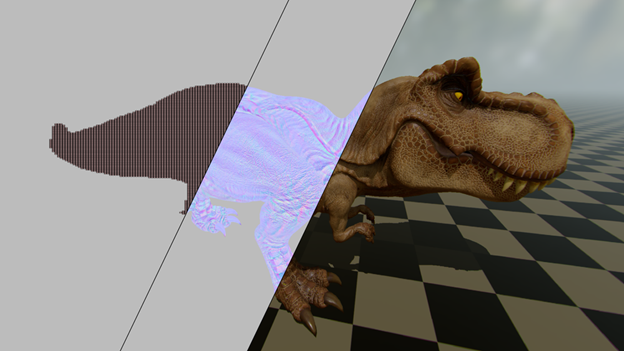Earlier this year, we published a blog post teasing our co-presentation of Cooperative Vectors with Microsoft at GDC 2025. During the presentation, we showcased a real-time demo that took advantage of cooperative vectors to efficiently compress PBR texture sets on Intel® Arc™ GPUs. This presentation is still available online through the GDC vault.

Cooperative Vectors allow the multiplication of matrices with arbitrarily sized vectors to be run on any shader stage. They can therefore be used not only for training AI models, e.g., using compute shaders, but also for real-time inference, and specifically per-pixel inference, to accelerate the execution of neural rendering techniques on hardware with AI acceleration. With this new feature, developers can unleash the full power of the XMX units on modern Intel GPUs. Cooperative Vector support will be available on discrete GPUs, such as Intel® Arc™ (A series and B series), and built-in Intel® Arc™ GPUs in Intel® Core™ Ultra Processors (Series 2).
Today, we’re excited to announce that our demo's source code is available on GitHub.
Our demo showcases how Cooperative Vectors can be used to efficiently implement a compression technique for PBR texture sets, which we refer to as TSNC (short for “Texture Set Neural Compression”). Cooperative Vectors offer a powerful vehicle to tap into the AI hardware acceleration available on modern DirectX 12 GPUs. By sharing our source code, we hope to encourage developers to explore the capabilities enabled by neural graphics and its applications to game titles. Our source code provides a hands-on example to explore this forward-looking approach to GPU programming. Note that this code release is a stand-alone application of TSNC, but we are also working on a more complete SDK to facilitate its adoption on the long run. More to come soon!
Built on Microsoft’s Agility SDK
To run the demo, you’ll need Microsoft’s Agility SDK 1.717-preview, which includes preview support for Cooperative Vectors. This SDK ensures compatibility with the latest DirectX 12 features and enables developers to test innovations ahead of broader API adoption.
What’s Inside the Repository?
- Complete demo source code showcasing the use of Cooperative Vectors
- Build instructions, requirements and assets
Whether you’re experimenting with novel rendering techniques, tuning for performance, or just curious about neural graphics as a new chapter in graphics, this demo is a great place to start.
Intel is excited to make our efficient AI hardware accessible through Microsoft DirectX’s Cooperative Vectors. We strongly believe that neural graphics is the right way to generate visuals in the future. We are committed to providing the best performance and developer experience across our discrete and integrated Intel Arc GPUs.
Get Involved We welcome feedback, contributions, and discussions from the community. Let us know how you're using Cooperative Vectors and/or how you'd like to see TSNC evolve. This is just the beginning of what’s possible when hardware and software innovation come together. Visit the GitHub repo to get started.